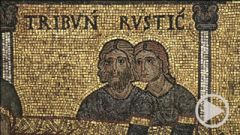The Conquest of Constantinople
Venice prospered. The Venetians were not only courageous mariners and canny tradesmen – they were also astute politicians. They didn’t kowtow to anyone, not even the Pope or the Emperor. Which is precisely why, when they weren’t bickering with them, they could serve as negotiators between the two.
In the year 1177, the Venetians organised a historic meeting between Emperor Barbarossa and Pope Alexander III. The “Peace of Venice” put an end to a decades-long power struggle between the two rivals. The agreement was reportedly sealed with a handshake here in the vestibule of St. Mark’s – in one of the greatest diplomatic triumphs of the Middle Ages. Just one generation later, Venice was to finally become the heiress to Constantinople – but this time through use of force.
The Europeans had already tried three times to win back the Holy Land from the Muslims. As the Fourth Crusade approached, the Venetians were no longer content to sit back and do nothing. They pledged to organise the passage of the crusaders to Egypt. But in 1202, just 12,000 men turned up in Venice instead of the expected 33,000.
A disaster! The crusaders were supposed to be covering their own transport costs. The Venetians had built more than 200 ships, curtailing their usual business for an entire year. Now the city was threatened with bankruptcy. In order to recoup at least some of their losses, the Venetians convinced the army of crusaders to conquer the wealthy port city of Zara in Dalmatia first.
And from here, they still did not proceed to Jerusalem but to Constantinople. The city had recently been the scene of some major unrest. Under the leadership of the Doge Enrico Dandolo, the Venetians scented a historic opportunity. They applied their powers of persuasion – and instead of saving the Holy Land, in the year 1204 the crusaders conquered the world’s largest Christian city!
The Pope was furious and excommunicated all Venetians – but they were not bothered in the least. Venice was at the zenith of its power. The former provincial city now ruled its mother country. And the Doge officially became “Lord of a quarter and a half of the Roman Empire” – according to his new imperial title.
Venice controlled the Mediterranean and trade routes with the Orient. The city was located at the culmination of the Silk Road, tradesmen such as Marco Polo travelled from here to China. The Serenissima Repubblica – or Most Serene Republic as it was known - was the world’s most important trading power.
Constantinople was systematically plundered. Ship upon ship brought unimaginable treasures back to Venice: Gold and silver, as well as the most precious icons, sculptures and reliefs. Naturally, the most beautiful pieces were destined for the state church.


